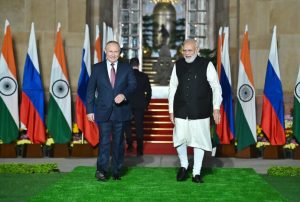India’s foreign policy is undergoing a new test of choices and partners in the international system. Such a dilemma of autonomy and engagement is not new in the history of India’s dealings with the world. However, the ongoing crisis in Ukraine, and the deep divisions it has created in the international community, stir up new questions about India’s foreign policy. Like a circle, is India’s multi-alignment a recycled version of its Cold War era non-alignment? Like a square, are India’s strategic orientations guided by the Quadrilateral Security Dialogue (Quad) partnership with the United States, Japan, and Australia in the Indo-Pacific? Do the new shifts in the European security order, following Russia’s invasion of Ukraine, and India’s abstention at the United Nations, create new grounds for an augmented triangle of Russia, India, and China?
The Multipolar Dilemma
Indian Foreign Minister S. Jaishanker, speaking at the Institut Français Des Relations Internationales (IFRI) in Paris, recently contended that the world was undergoing “profound geopolitical, geo-economic and technological changes.” There is a broader consensus that the world is no longer bipolar or unipolar, but there remain uncertainties about the features of the emerging multipolar world order. Even as the Indian government professes a belief that India’s interests will be best served in a multipolar world order, its gains are not preordained.
From non-alignment to multi-alignment, India’s primary quest has been the practice of strategic autonomy to protect and promote its national interests amid the world’s stormy geopolitics. Today’s India is materially more endowed and overtly more aspirational in the search for its rightful place in the international system. Even in times of non-alignment of the Cold War era, which the West erroneously projected as “neutrality,” reticence on world affairs has never been in Delhi’s DNA. Therefore, at a time when Delhi’s military, diplomatic, and economic resources provide it more latitude than ever before, its positions on matters of international concern are watched with more scrutiny.
As Russia’s relations with the West and the United States in particular hit a nadir, India’s diplomatic tightrope walking looks even more strained. In any conflict scenario, wherein Delhi has no particular influence to shape the outcomes, its first priority has been to evacuate its citizens. Hence, in the Ukraine crisis, the Indian government has focused on safely bringing back Indian students caught in the conflict. However, India’s abstention at the United Nations carries a deeper geopolitical rationale. India’s strategic partnership with the United States and with many other U.S. allies in the Indo-Pacific has grown deeper and broader in recent years, keeping in mind the challenge of managing an assertive China. Nevertheless, India’s defense partnership with Russia continues to be a primary ingredient of India’s military preparedness and there is no even alignment between Delhi and Washington on Russia as a threat perception. While the Indian foreign policy establishment invested in the Quad, and its military carries out sophisticated interoperability exercises and signs foundational agreements with the U.S., defense purchases and co-production with Moscow remain a backbone of India’s military hardware. What makes this geometry of India’s foreign policy more complicated is the growing strategic alliance between China and Russia, with an intention to keep the West in check, at a time of fragile India-China security dynamics.
Practicing Strategic Autonomy Is Not Outdated
India’s penchant for practicing strategic autonomy is steeped in its history of international relations, and in its geography that puts a premium on maintaining independent agency, even at the cost of being called a benchwarmer. India, despite being the most preeminent country in South Asia, has to deal with a neighborhood with two hostile nuclear powers: China and Pakistan. Moreover, the continental and maritime environment in South Asia has seen unmistakable Chinese footprints in the security and economic realms. In such a milieu, Delhi finds it prudent to condemn the violence and loss of lives because of Russia’s invasion of Ukraine while avoiding directly joining the West in calling out Russia’s behavior in international platforms. The realpolitik playbook guides Delhi to keep its distance from a conflict that has deep historical and geopolitical roots in the unfinished business of post-Cold War European security order and the continuing faceoff between NATO’s eastward drive and Russia’s insecurity.
No doubt, India’s foreign policy is at crossroads, in view of its growing ties with the West, and its own conception of dealing with inherent security threat perceptions in its immediate and extended neighborhood. New geopolitical currents, primarily resulting from China’s military and economic rise, have brought Delhi closer to Washington and its allies. But China-U.S. competition and the deterioration of Russia-U.S. relations have brought Beijing and Moscow into a closer strategic embrace. Meanwhile, Pakistan is playing a new strategic gambit, in addition to its strategic alliance with China, and its complicated ties with the U.S., through its new outreach to Russia. Going by the popular adage, India is indeed living in “interesting times.”
There are a number of future scenarios that could unfold, setting forth a new geometry in India’s foreign policy. India’s response to the Ukraine crisis and the ensuing geopolitical fissures have unfolded a divided debate on the direction of India’s foreign policy. Will India, after testing the grounds of engagement with the West come full circle back to a newer version of non-alignment? Despite some hiccups in the tilt to the West, will India, given the mounting China challenge, stick to its commitments to the Quad and its strategic permutations and combinations? Alternatively, will the current geopolitical churning, and louder calls for choosing sides in the international system, lead to a new offspring of understanding in the triangular formation of Russia, India, and China?
Ultimately, India’s foreign policy direction may not follow any of these geometric designs, but rather take a more flexible path. These formulations may at the outset seem contradictory, but the test of a foreign policy is in holding contrasting directions and still finding the dexterity to operate and move in order to protect and promote India’s national interests.

































